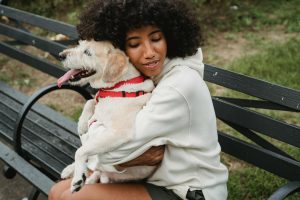When it comes to dog training, a lot of people make the mistake between trigger and distraction. Both of these terms can present challenges to your dog and your obedience training sessions. But there is a difference between them.
There are bazillion different distractions out there. They are different for every dog. When dealing with distractions, the most important thing is to teach manners and proper training. We can use manners training protocols to build up that stamina and make your dog listen even when there is a distraction around.
Triggers are something different. Today, we will try to explain them and how your dog reacts to triggers and distractions.
What is a distraction?
Distraction is anything that happens around your dog when he performs a behavior. It can be something as little as a small stone falling next to your dog. Or a bigger thing like a squirrel running across the yard. The sound of the doorbell, or anything else. The simple definition is anything your dog finds exciting or disrupting.
Sometimes, even good things, like extra-special treats can act as distractions. When you work on training and manners, it is important that you teach your dog to handle duration and distance before you add distractions.
As I have talked about many times, you first start in a neutral zone, like your home. Then, you add duration and distance to the same behavior. And only then do you move outside and do some training with small distractions.
The good news with distractions is you can train your puppy to ignore them. Yes, they will be tempting in the beginning. But eventually, with proper and consistent training, you can shape your dog.
What is a trigger?
Unlike distractions, triggers are something that make your dog feel fear, excitement, frustration, anger, anxiety, and more. It is something that creates an emotional response in your dog.
Sadly, unlike distractions, triggers are harder to handle. For example, most dogs are afraid of fireworks. It is not a distraction, it is a trigger that makes your puppy feel anxious and stressed.
Milo, for example, is afraid of thunderstorms. If we are outside, and he hears a thunderstorm, he goes into a frenzy anxious state. There is no command or cue that he will listen to, he only wants to get to a safe place. That is the car or our home.
The same thing can be a trigger and distraction
As I said before, triggers and distractions are different. But the same thing can be a trigger and distraction. For example, the doorbell ringing.
In some cases, dogs find a doorbell ringing to be a distraction. They will look at you, walk to the door, or even run to the door. Your dog is exciting and might struggle to sit on cue. Yes, he is excited, but your puppy is not having an overwhelming emotional response.
For dogs that the doorbell is a trigger, they have an overwhelming emotional response. This is the key to understand the difference, that “overwhelming response”. In this case, your dog might start growling, barking, freezing, running away, or doing all sorts of things to get his emotions under control.
The Same Trigger can be good or bad
Triggers can sometimes be good or bad. I didn’t say all triggers are bad. In fact, sometimes, the same trigger might be viewed as good or bad. It depends on what your dog associates with the trigger.
For example, let’s say you have a dog that loves car rides. The moment you pick up your car keys, he is overwhelmed with excitement. He knows he is coming to the car and going on a ride.
On the other hand, if you have a puppy that is anxious and stressed during car rides, you picking up the keys is a sign something bad is going to happen. You might see your dog go back into his bedroom and refuses to go out.
The Science behind Dog’s Triggers
Let’s try to understand and explain triggers scientifically. What happens when your dog is triggered? A neurochemical release happens. The same happens with people. This neurochemical release tells our body to prepare and that something is going to happen. Our body gets ready. It could be something uncomfortable, interesting, exciting, something we love, or something we hate.
Your dog’s response to the trigger will depend on what happens around the trigger. And then we have to talk about trigger stacking. It is something that will put your dog over the threshold. Sometimes, your dog might handle one trigger. But multiple triggers happening one after another? Then your dog is into the red zone, he has tripped over the edge, and he can no longer hear you or notice things.
For example, Milo might handle a small thunderstorm. And he can control himself after 10 to 20 seconds. But because thunderstorms usually do not come in a single package, he quickly goes over the threshold and pays attention to absolutely nothing. His instinct to get back to a safe place kicks in.
How to identify aggression triggers and handle them?
Some common triggers can trigger a dog’s aggression. Some examples include:
- Being touched
- Being picked up, having the ears cleaned
- Dogs who haven’t been socialized around young children might be triggered by fast and unpredictable movement
- Unusual objects in the environment, say balloons or big objects
- Sudden loud noises, such as thunderstorms, gunshots, and fireworks
The good news is that you can handle most triggers easily by socialization and desensitization. For example, if your dog is triggered by touch, you can teach your dog how to love people and enjoy being touched.
If your dog reacts when toddlers run, you have to socialize it with more children. As I have said multiple times, socialization is more than just meeting other dogs and playing with them.







